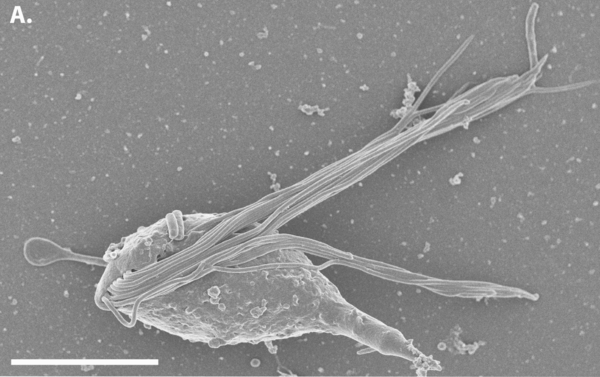Cthulhu macrofasciculumque
Classification
Higher order taxa
Eukaryota ; Excavata ; Metamonada ; Parabasalia ; Parabasalia incertae sedis
Species
Cthulhu macrofasciculumque
|
NCBI: Taxonomy |
Description and Significance
Cthulhu macrofasciculumque is a symbiont of the termite Prorhinotermes simplex, and was found in its hindgut. It is a parabasalid, a group of protists best known for their ability to break down lignocellulose and their common cellular structure accentuated by the presence of multiple flagella. C. macrofasciculumque has a bundle of twenty flagella on its anterior end, and may have a singular flagella on its posterior end. It is an intermediate sized protist, and has been measured to be 17.8 to 23.3 um long. Because of the diversity of cellular morphology and complexity found in the parabasalids, C. macrofasciculumque is being looked at as a model organism alongside Cthylla microfasciculumque to describe the link between less complex parabasalia and the hypermastigotes that have over 50,000 flagella and are large enough to be seen by the naked eye.
Its name is derived from one of science fiction writer H. P. Lovecraft's monsters, Cthulhu, first described in his short story "The Call of Cthulhu". This monster is an ancient alien with the head of an octopus, wings of a dragon, and a body with claws that lives deep within the ocean, and the flagella of C. macrofasciculumque may remind people of squid-like tentacles.
Genome Structure
Genome is unsequenced as of April 2013. By sequencing its SSU rRNA, C. macrofasciculumque was found to be most similar to the Hexamastigidae family of microorganisms.
Cell Structure, Metabolism and Life Cycle
C. macrofasciculumque has a tuft of twenty flagella which it uses to swim, beating them synchronously to propel itself. Its presence in the termite gut as a symbiont suggests an ability to break down lignocellulose. However, more characterization of this microbe is needed to be sure that it plays a role in this metabolism.
Ecology and Pathogenesis
C. macrofasciculumque was found in a lower termite, P. simplex, alongside other larger parabasalid members previously well described (Holomastigotoides and Pseudotrichonympha). It is considered to be a symbiont of the termite, and is therefore non-pathogenic.
References
Lovecraft, H. P. "The Call of Cthulhu". H.P. Lovecraft: The Fiction. 2008.
Author
Page authored by Graden Barnes and Michael Paxhia, students of Professors Edward Walker and Kazem Kashefi at Michigan State University.

